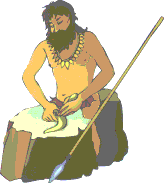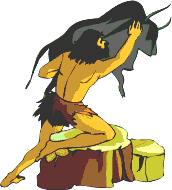Tools, Intelligence, and Definitions of Man
One of the most important problems involved in looking at the
question of the evolution of man is the question of how you define man.
From a biblical perspective, this is not much of an issue. Man is defined
biblically as "that being created in the image of God." In the Genesis account,
man is clearly separated from the rest of the creation by being created in
God's image. The challenge to this notion involves how we know it is true.
A skeptic who does not believe in God will suggest that this is just a religious
ego trip with no basis of support. Many animal rights activists assert that
we have no special place in the creation, and no right to use animals for
food, medicine, clothing, or all the other things that we use animal material
for.  In physical anthropology class in college, you may have been given a list
of criteria that an animal must have to qualify as being human. Involved
in this list would be things like brain size, the location of the foramen
magnum (the opening to the brain that the spinal column passes through),
the size of the eyebrow ridges, the shape of the back of the skull, the arrangement
of the teeth or of the cusps in the teeth, and perhaps the ratio of body
limbs. All of these characteristics are physical characteristics. Many
claims that say that a specimen is an ancient ancestor of man are based upon
the fact that the specimen found had one of the criteria listed above.
In physical anthropology class in college, you may have been given a list
of criteria that an animal must have to qualify as being human. Involved
in this list would be things like brain size, the location of the foramen
magnum (the opening to the brain that the spinal column passes through),
the size of the eyebrow ridges, the shape of the back of the skull, the arrangement
of the teeth or of the cusps in the teeth, and perhaps the ratio of body
limbs. All of these characteristics are physical characteristics. Many
claims that say that a specimen is an ancient ancestor of man are based upon
the fact that the specimen found had one of the criteria listed above.
In cultural anthropology the criteria for determining if a specimen was human
might include tool construction, the use of fire, evidence of language (not
just communication), and signs of organized communities. The problem with
this definition is that the more we learn about animals, the more we see
that animals can do most of the things that have in the past been thought
to be peculiar to man. In USA Today
(August 9, 2002, page 2A), there is a story about a crow at Oxford University
that has learned how to make tools. Researchers put a piece of food in a
tube and laid two wires out for the crows to use to get the food--a straight
wire and a hooked wire. The crows quickly used the hooked wire to get at
the food. When only one hooked wire was available, the crow without the
hooked wire took the straight wire and using its beak made a hook and then
fished the food out of the tube.
 Over the years researchers have
seen animals use rocks to break things to get at the food inside. Chimps
use sticks to reach into tree trunks to get insects to eat. Birds drop small
rocks while in flight on eggs of other birds to break them, and eat them.
I am reminded of a comment that the famous archeologist Louis Leakey made
when Jane Goodall discovered chimps using tools. He said "Either we are
going to have to change our definition of man, or we are going to have to
invite the chimps to send a representative to the United Nations."
Over the years researchers have
seen animals use rocks to break things to get at the food inside. Chimps
use sticks to reach into tree trunks to get insects to eat. Birds drop small
rocks while in flight on eggs of other birds to break them, and eat them.
I am reminded of a comment that the famous archeologist Louis Leakey made
when Jane Goodall discovered chimps using tools. He said "Either we are
going to have to change our definition of man, or we are going to have to
invite the chimps to send a representative to the United Nations."
It should he obvious that intelligence is not the issue here. Crows do interesting
things, but they are not of high intelligence. Insects also do remarkable
things, and clearly intelligence is not what gives them the ability to do
it. Retarded humans might not be able to do some of the things that animals
do. What is it about man that we can use to demonstrate that the definition
of man as that being created in the image of God is valid?
We would suggest that there are many things that can be seen in man which
demonstrate his creation in the image of God. Let us look at a few briefly.
 Creativeness. Man's ability to create
art, music, abstract ideas, and to be taught to think in these areas is unique
to man. None of these things are a function of man's intelligence. Retarded
people do these things, and in many cases do them incredibly well. Animals
with very high intelligence do not do these things. There have been claims
of elephant art and chimp art and the like, but when you examine these claims
they are anthropomorphizations and not creations which demonstrate a spiritual
make up.
Creativeness. Man's ability to create
art, music, abstract ideas, and to be taught to think in these areas is unique
to man. None of these things are a function of man's intelligence. Retarded
people do these things, and in many cases do them incredibly well. Animals
with very high intelligence do not do these things. There have been claims
of elephant art and chimp art and the like, but when you examine these claims
they are anthropomorphizations and not creations which demonstrate a spiritual
make up.
 A Concept of God. Why
does man worship God? Why do we seek God? What is it that causes us to
want to worship. Why do we seek heaven and fear hell? Once again, we do
not see this in any way in other life forms on our planet, and we do see
it even in the most feeble minded among us.
A Concept of God. Why
does man worship God? Why do we seek God? What is it that causes us to
want to worship. Why do we seek heaven and fear hell? Once again, we do
not see this in any way in other life forms on our planet, and we do see
it even in the most feeble minded among us.
A Concept of Self. What
is it that makes us want to be remembered when we die? Why do we bury the
body and erect a stone or other memorial for a family member? Why are we
willing to die for an idea, or what makes us worry and why do we seek forgiveness
of others. What causes us to experience guilt? All of these things are
a manifestation of the fact that we are aware that we are an individual with
an identity that goes beyond survival.
These are not survival
skills. They do not make us more fit for survival. They are not a function
of our IQ and they do not depend on our culture or our education. All people
in all societies do these things and have these characteristics. Our tools
and our bodies are not what make us human. How God formed our bodies is
not really the issue about what it is about man that sets man apart. It
is our soul that sets us apart, and the evidence that we are spiritual beings
is seen in those characteristics which are uniquely seen in every one of
us. The challenge to each of us is to make sure that this soul which is
uniquely created and which is the real person is in a saved relationship
with the God who created it. "The spirit itself beareth witness with our
spirit, that we are the children of God" (Romans 8:16).
--John
N. Clayton
Back to Contents
Does God Exist?, MarApr03.
 In physical anthropology class in college, you may have been given a list
of criteria that an animal must have to qualify as being human. Involved
in this list would be things like brain size, the location of the foramen
magnum (the opening to the brain that the spinal column passes through),
the size of the eyebrow ridges, the shape of the back of the skull, the arrangement
of the teeth or of the cusps in the teeth, and perhaps the ratio of body
limbs. All of these characteristics are physical characteristics. Many
claims that say that a specimen is an ancient ancestor of man are based upon
the fact that the specimen found had one of the criteria listed above.
In physical anthropology class in college, you may have been given a list
of criteria that an animal must have to qualify as being human. Involved
in this list would be things like brain size, the location of the foramen
magnum (the opening to the brain that the spinal column passes through),
the size of the eyebrow ridges, the shape of the back of the skull, the arrangement
of the teeth or of the cusps in the teeth, and perhaps the ratio of body
limbs. All of these characteristics are physical characteristics. Many
claims that say that a specimen is an ancient ancestor of man are based upon
the fact that the specimen found had one of the criteria listed above.  Over the years researchers have
seen animals use rocks to break things to get at the food inside. Chimps
use sticks to reach into tree trunks to get insects to eat. Birds drop small
rocks while in flight on eggs of other birds to break them, and eat them.
I am reminded of a comment that the famous archeologist Louis Leakey made
when Jane Goodall discovered chimps using tools. He said "Either we are
going to have to change our definition of man, or we are going to have to
invite the chimps to send a representative to the United Nations."
Over the years researchers have
seen animals use rocks to break things to get at the food inside. Chimps
use sticks to reach into tree trunks to get insects to eat. Birds drop small
rocks while in flight on eggs of other birds to break them, and eat them.
I am reminded of a comment that the famous archeologist Louis Leakey made
when Jane Goodall discovered chimps using tools. He said "Either we are
going to have to change our definition of man, or we are going to have to
invite the chimps to send a representative to the United Nations." Creativeness. Man's ability to create
art, music, abstract ideas, and to be taught to think in these areas is unique
to man. None of these things are a function of man's intelligence. Retarded
people do these things, and in many cases do them incredibly well. Animals
with very high intelligence do not do these things. There have been claims
of elephant art and chimp art and the like, but when you examine these claims
they are anthropomorphizations and not creations which demonstrate a spiritual
make up.
Creativeness. Man's ability to create
art, music, abstract ideas, and to be taught to think in these areas is unique
to man. None of these things are a function of man's intelligence. Retarded
people do these things, and in many cases do them incredibly well. Animals
with very high intelligence do not do these things. There have been claims
of elephant art and chimp art and the like, but when you examine these claims
they are anthropomorphizations and not creations which demonstrate a spiritual
make up.  A Concept of God. Why
does man worship God? Why do we seek God? What is it that causes us to
want to worship. Why do we seek heaven and fear hell? Once again, we do
not see this in any way in other life forms on our planet, and we do see
it even in the most feeble minded among us.
A Concept of God. Why
does man worship God? Why do we seek God? What is it that causes us to
want to worship. Why do we seek heaven and fear hell? Once again, we do
not see this in any way in other life forms on our planet, and we do see
it even in the most feeble minded among us.